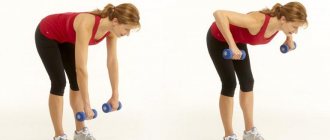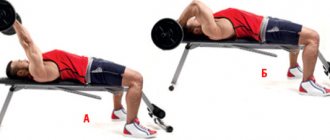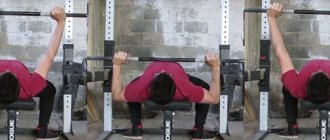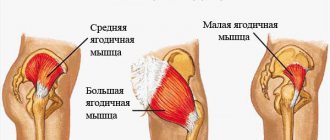Hi all! Today we’ll talk about a basic exercise in bodybuilding – the bench press. Surely everyone who works out in the gym has included it in their training program - including representatives of the fair half of humanity.
For girls, this exercise is also necessary, but they, most often, do not chase the scales, unlike men. But we’ll talk about this in another publication. Not everyone knows how to perform the bench press correctly, because the technique of this exercise directly affects not only the results, but also safety in general.
The step-by-step instructions below will help you perform the bench press correctly, which in turn will allow you to increase your strength in this exercise. So, go ahead.
- Correct hand position
#1 Emphasis on the positive phase of the movement
Error
You can often find that athletes slowly lift the barbell and then quickly throw it down . Some are so carried away by this technique that they turn their chest into a kind of trampoline, from which the barbell bounces vertically upward.
With this technique, the bar goes through the negative phase almost like lightning, and it is during this phase that the muscle fibers do a tremendous amount of work resisting the force of gravity. The stretching increases, the muscles experience overload. The result is microdamage that activates the growth mechanism of muscle tissue. Without an emphasis on the negative phase, it will not be possible to achieve such an effect in full, so the effectiveness of the exercise will noticeably decrease.
Solution
How to do a bench press with a barbell correctly, taking into account the emphasis on the negative phase? Everything is extremely simple. As the bar moves downwards, you need to continue to resist the weight of the bar until the lowest point and feel the muscle tension until the bar is at the minimum distance from the chest. Here you need to take a short break and begin the positive phase of the exercise.
The main rule of bench presses is that in the negative phase the barbell should lower a little slower than it rises in the positive phase. Violation of the speed limit will immediately affect the effectiveness of the exercise.
Application
Intended for: Everyone, from beginner to professional.
When: At the beginning of a chest workout. Halfway through your workout, perform dumbbell bench presses and dumbbell flyes on a bench.
How much: 3-4 sets of 8-12 reps.
Sports instruction: No exercise stands next to the bench press in solving the problem of dramatically increasing the volume of muscle mass and power of the chest muscles. And although the center of the load here is directed to the middle of the chest, its lower and upper parts work at full strength. But know that this load distribution is good when you hold the bar with a wide grip. If the grip is strictly shoulder width, then the center of the load moves towards the top of the chest.
The muscles involved in the bench press are of great importance for many sports that involve push-ups, push-ups, punches and throws: boxing (lateral and direct blows to the body), tennis (hitting the ball with an open racket), discus throwing and shot put.
#2 Straight trajectory
Error
One of the most popular mistakes is the straight trajectory of the bar during the exercise. This technique does not provide the opportunity to develop maximum strength and can injure the shoulder joint.
If the bar moves in one plane over the top of the pecs (photo on the left), at the bottom point the angle at the elbows will be exactly 90 degrees. The upper part of the shoulder will press the rotator cuff against the acrominoclavicular joint, which can result in pain in the shoulder joint , cause inflammation and, in some cases, result in injury.
To level the load on the shoulder joint, the bar must be lowered to the lower part of the pecs. However, a straight trajectory (shot in the middle) will also be a mistake here: at the top point above the chest, the barbell is not easy to hold . As a result, working with heavy weight will become problematic.
Since a straight trajectory is undesirable, performing presses on a Smith machine is not recommended.
Solution
Ideally, the barbell should move strictly diagonally. At the lowest point it will be at the level of the lower pectoral muscles, and at the upper point it will be above the deltoids. This technique will give you good weight control and minimal chance of damaging your shoulder joint.
Bench press: general provisions
This is one of three basic exercises that helps develop the chest muscles, triceps of the arms and the shoulder girdle in general. Nothing loads the chest as much as performing this exercise in its various variations.
It is somewhat reminiscent of push-ups, but by using additional weights (dumbbells or barbells) the effect is greatly enhanced.
There are several types of barbell press:
- horizontal;
- on an inclined bench;
- on a reverse-incline bench;
- bench press in powerlifting.
You might think that their technique is 100% similar, but each type has its own subtleties.
Classical
Here the pectoral muscles work over their entire surface, and the triceps and shoulder girdle are secondarily “connected”. It is the classic version of the bench press that allows you to develop a powerful chest. We will look at how to do it correctly step by step a little later. Now I want to show you the starting position:
- lying on a horizontal bench, remove the barbell with both hands;
- while inhaling, slowly lower it to the middle of the chest;
- press the barbell up while exhaling;
During the exercise, we lean on the full sole of our feet. The buttocks are pressed against the bench. The chest is pushed forward. The back is slightly arched.
If you are doing bench presses for the first time, it is better to practice the technique on an empty bar, underweighting the weights until you feel the correct movement. Then you can gradually add weight, still concentrating on technique.
Angle press
For this exercise you will need an incline bench. The technique is similar to the previous version, but due to the 30-degree angle, the main load will fall on the upper part of the pectoral muscles.
How does this press differ from the classic one:
- the barbell should be lowered to an area that is closer to the neck - but not directly on it;
- Here the elbows are brought forward, slightly spread to the sides;
- Be sure to keep your brushes straight, do not tilt them back.
In addition, bodybuilding also suggests that both of these exercises can be performed with dumbbells. In this case, the execution technique is the same, only you still need to make sure that both hands act synchronously and there is no lag.
For all variations of the press, your legs should be kept on the floor, without lifting them up.
Reverse Incline Press
This variation is almost the only exercise that very well pumps up the “undercut” - the lower pectoral muscles. It puts much less strain on the shoulders and lower back than the classic bench press.
It is most effective to choose a bench with an incline of 40-45 degrees. Lie down on it and firmly fix your legs.
Remove the barbell from the racks and slowly lower it to the bottom of your chest as you inhale. Exhale slowly as you squeeze.
In powerlifting
Powerlifting is a discipline where the important indicator for the athlete is the weight taken, and not the aesthetic component. Therefore, an exercise in competitions is performed not for the number of repetitions, but for the maximum weight that the athlete can lift in his weight category.
Here the bench press is the second exercise in the program of any competition. And his correct technique is different from that presented in bodybuilding.
So, the bench press in powerlifting has the following features:
- during execution, the athlete touches the bench with his shoulders and buttocks, making a so-called “bridge” - which is unacceptable in bodybuilding and, in addition, is very dangerous;
- legs are widely spaced and stand as close to the shoulders as possible;
- The bench press is not performed with a narrow grip, but with the widest possible grip – 80 cm or more;
- the movement of the bar should be progressive and not like a jerk.
In addition, you need to monitor the position of your hands - they should not collapse under the weight of the projectile.
#3 Incorrect position of the shoulder blades
Error
Often, during bench presses, all attention is directed to the correct position of the elbows and wrists, and many simply forget about the back muscles. However, the position of the back plays a key role in distributing the load to the pecs. The shoulder blades are especially important: if you don’t bring them together during presses, you will transfer the load from your pecs to your shoulders .
It all happens as follows. If the shoulder blades do not come together, this is immediately reflected in the pectoral blades, which stop arching forward. An insufficiently arched chest during bench presses leads to a series of consequences: the trajectory of the movement increases, and the bar and forearms travel more distance per repetition. At the lowest point, a significant part of the load falls on your shoulders and you risk “breaking” them when working with heavy weight.
Solution
How to do a bench press with a barbell correctly so that your shoulders say “thank you” to you? Even before starting the presses, make sure that your shoulder blades are brought together . Imagine that there is a pencil sandwiched between them. Try to keep your shoulder blades in this position throughout the entire set of barbell presses. At the top point, the position of the shoulder blades should not change even though it is quite difficult to keep them retracted.
Throughout the entire exercise, your pecs should be convex like lenses. Don't worry that this will shorten the trajectory. The price is only a couple of centimeters, but your shoulders will be reliably protected from overloads.
Correct breathing
Inhalation is done when taking the starting position, when you grab the barbell with your hands. Lowering the projectile is performed without exhalation. Air-filled lungs provide maximum stretching of muscle fibers, allow you to fix and keep your shoulder blades retracted, which helps maintain tension in the muscles of the entire body.
You can’t exhale at the lowest extreme point either. Here you need to hold your breath. Thanks to this, it becomes possible to perform a fairly powerful push. If you exhale, your chest will simply deflate. Exhalation is done only at the top point. The main thing is not to completely empty your lungs when exhaling.
#4 Lack of arching in the lower back
Error
A flat back during bench presses is not a critical mistake, but it can still reduce the effectiveness of the exercise. The deflection in the lower back allows you to better expand the pecs outward, which causes them to stretch at the lowest point . Moreover, in this position it is easier to control the weight, so experienced bodybuilders often deliberately increase the arch in the lower back.
Solution
During bench presses, only the buttocks, shoulder blades and the back of the head should be in contact with the bench. 1-2 centimeters between the lower back and the bench .
When performing heavy bench presses, arching your lower back may pose a risk of back injury. To prevent this from happening, we recommend increasing the load gradually and not taking too much weight. To be on the safe side, you can take a weightlifting belt , which will reduce the likelihood of injury and stabilize the body during exercise.
Bench press technique
A basic exercise in strength sports such as bodybuilding and powerlifting is the bench press. It is designed to develop the pectoral muscles (major, minor, serratus anterior), arms (biceps, triceps) and the anterior deltoids. The bench press has several options: classic, touch, lying in a power rack, on an inclined bench. Each exercise differs in technical execution and is aimed at achieving a specific physical result. A program to increase the bench press should include various types of this element depending on the athlete's goals. Let's take a closer look at each type of technology.
#5 Incorrect grip
Error
One of the most serious mistakes that can cost you your health. It consists in taking the bar with a monkey grip , when all the fingers are on one side (photo on the left). It would seem that this position of the fingers seems justified: the bar is as close as possible to the lower part of the palm above the radius. This technique helps you cope with bench presses easier and even lift more weight. However, there is one “but” that covers all these advantages.
When the fingers are on one side, there is a risk of the bar falling off . This happens so quickly that even a dozen backups cannot save you. The bar may fall on your chest or throat, causing internal bleeding or simply suffocating you. It is for this reason that using a monkey grip for bench presses is often called a suicide grip , and you can only use it after making a will.
Solution
Take the barbell so that your thumb and the other four fingers are on opposite sides of the bar. Squeeze the bar tightly so that it does not move around in your palm. This way you will have complete control over the weight and protect yourself from the bar falling.
Try to hold the barbell so that the bar is closer to the bottom of your palm (photo on the right). This technique will help to avoid bending in the wrists when the working weight is too heavy.
Why do the bench press?
The bench press is one of the basic exercises for the muscles of the upper body. Regardless of gender, you should definitely include it in your strength training because it:
- Helps pump up the pectoral muscles . The bench press loads them better ACE-Sponsored Research: Top 3 Most Effective Chest Exercises than all other exercises, including crunches and machine presses, dumbbell flyes and dips.
- Pumps up his hands . The bench press is also a great workout for the A Comparison of Muscle Activation Between a Smith Machine and Free Weight Bench Press triceps—the muscles at the back of the shoulder—and the anterior deltoids, which cover the front of the shoulder joint.
- Involves many other muscles . In addition to the main ones, the work also includes the middle deltoids, latissimus dorsi and biceps. The bench press will strengthen your entire upper body and train your muscles to move in a coordinated manner.
- Strengthens bones . Like other strength exercises, the bench press helps strengthen bones and is even used to treat The impact of adding weight-bearing exercise versus nonweight bearing programs to the medical treatment of elderly patients with osteoporosis.
- Does not require long development . You don't need much flexibility or balance to perform the bench press. The exercise is simple and functional, so any beginner can do it correctly if they remember the basic points of the technique.
- Has different variations . By changing the inclination of the bench and the width of your grip, you can shift the focus to certain muscle groups and harmoniously pump up your chest and arms.
#6 Lack of safety net
Error
One of the most critical mistakes during bench presses is the lack of a spotter who can come to the rescue during a failure repetition. Without a safety net, the barbell can easily land on your chest, neck, or head. It can all end in intensive care, as in the case of the monkey grip.
Solution
To be on the safe side, you can use special racks that will prevent the barbell from falling during a failure repetition. Ideally, the racks should be wide enough so that the bar cannot miss them - this also happens.
two horizontal benches instead . If they are too low or high, then you definitely need a belayer. Ask anyone in the room to help, tell them how many repetitions you are going to do and which of them you think might be a failure. Choose your belayer carefully so that it doesn’t turn out to be a kid who will land on you along with the barbell in case of failure.
Have you decided to perform bench presses without racks and a spotter? Here are some tips on what you can do in an emergency:
- The surest way to avoid unpleasant consequences is to quickly call someone for help . Compared to the no-lock press or belly roll technique, this is the safest way to avoid injury.
- Try to press without locks on the bar . In case of an emergency, tilt one part of the bar so that the plates fall to the floor. After this, you can repeat the same with the other side of the brief. When dropping weights, try to hold the bar very tightly, as it can fly upward like a catapult.
- If you press with locks, if it is impossible to squeeze the bar, you need to carefully lower it onto your chest and try to roll it down to your lower abdomen , tensing your abs. Once this happens, slide your body towards the counter. The bar should be on your hips. Calmly lift your torso and transfer the barbell from your hips to the bench. Roll the bar closer to the rack and place the bar on it using a deadlift.
Bench press program for mass and strength
To build muscle in your upper body and increase strength, you need to make the bench press a key part of your workout. We bring to your attention a program that puts a serious load on the pectoral muscles and provides weight gain of up to 10 kg in 3 months. To avoid overtraining and injury, it is advisable to carry out such training once a week, completely eliminating isolated triceps exercises. The complex consists of exercises: push-ups and bench press.
Strength and mass program:
- The first week is bench press from the floor in a power rack. The exercise is performed lying on the floor, the bar is fixed at the height of the forearms (elbows should lightly touch the floor). Press the barbell up with maximum explosive force each time to engage all the muscles and tendons involved in this strength element. 100% weight is the weight you can lift 5 times using the technique described above. We perform 5 sets of 5 repetitions in the following order: warm-up (2 sets with a weight of 50% and 75%), 2 working sets (weight 100%), 1 technical (weight 75%). Rest between working sets - at least 3-4 minutes.
- Second week – weighted dips. The principle of loading is the same as in the bench press. Perform 5 approaches 5 times: 2 warm-ups, 2 working, 1 technical. The exercise is performed from a standing position on a support in the uneven bars: inhale - press yourself and the weight upward on straight arms, exhale - return to the support.
- Week three – bench press in a power rack. Fix the barbell at the lowest point (5 cm above the chest), perform the load in the same way as in the exercises above - 5 sets of 5 times. First, press the weight up, then lower it onto the support.
Over the course of three weeks, you do three workouts consisting of one exercise. After this, increase your working weight by 2.5-5 kg and go through the cycle all over again. If you were unable to complete the required number of repetitions, then try to compensate for the load in the next lesson. On average, after three to four cycles, your working bench weight should increase by 7.5-12.5 kg.
#7 Incorrect position of the fifth point
Error
Often many people lift their butt off the bench during bench presses. In essence, this technique is cheating, reducing the effectiveness of the exercise. Due to the elevated position of the body, the trajectory of the barbell movement is noticeably reduced. As a result, your pecs work at half strength.
Solution
The fifth point should fit snugly against the bench before starting the exercise. This position must be maintained consistently throughout the repetition, even at the highest point. At the same time, do not forget about the arch in the lower back and arched chest.
Adviсe
- Don't pause at the bottom. As soon as the barbell touches your chest, do not relax your muscles and, using the energy available in them, press the barbell up. By stopping, you reflexively worsen muscle contraction and, in order to squeeze the barbell, you will need to “gather all your strength into a fist” again, spending additional energy on this. In addition, with each new repetition it will become more and more difficult to do this. Ultimately, you may not complete the intended number of repetitions.
- Stopping your breathing during the bench press is extremely important for keeping your torso in a safe, stable position and helps you develop a significantly stronger load. Do not forget, the more stable the position of the torso, the more intense the work of the muscles and the less pressure on the joints.
- Don't stop breathing for too long. When performing the exercise at an average pace, holding your breath should last about 2-3 seconds.
- After going through the most difficult part of the movement while lifting the bar, finish the repetition with a deep exhalation. If you feel a lack of strength, ask your partner for help. Never stop halfway! The barbell must be in motion all the time.
- The heavier the barbell, the more tense the muscles are and the more you have to exhale as you go through the toughest part of the barbell lift.
- When pressing the barbell, press your feet into the floor with all your might, hold the bar as tightly as possible, and do not lift your shoulders and hips off the bench. This will stabilize the torso and allow you to achieve maximum contraction of the chest muscles.
- At the bottom, do not squeeze the barbell with your chest, bending your whole body upward. This can cause injury!
#8 Weight set incorrectly
Error
Sometimes athletes set the same weight on both sides of the bar, but the layout of the plates on each side is different . For example, on the right there are pancakes of 5, 10 and 15 kg, and on the left there are 2 pancakes of 15 kg each. It would seem that the weight on the right and left is balanced, but everything is not so simple. Due to the different set of plates, the center of gravity of the bar shifts. The load will be distributed unevenly, and performing presses will be much more difficult.
Solution
Try to hang the weights on the bar symmetrically so that the center of gravity of the bar is strictly in the center. The pancakes must be the same in weight and size and be securely fastened with locks.
Dojims
The push-up technique is used to increase the strength performance of athletes in strength sports and as a way to combat adaptation to training, which is accompanied by a lack of progress. It is performed using the classic bench press technique, but the bar does not fall to the chest. There are different options for boosters, for example, the bar can be lowered by 10-20 cm or even lower. The weight is selected depending on the main goal of the workout. To increase the strength of the athlete, the exercise is performed with a large weight, but a small amplitude of push-ups for 2-4 repetitions.
#9 Incorrect wrist position
Error
During bench presses, gravity inevitably pulls the bar and the weight down. If your wrists are bent backwards, all that force will stretch the wrist muscles. Such a mistake will significantly increase the risk of losing control of the weight or getting a wrist injury , which will take you out of the training process for a long time.
Solution
The wrists need to be aligned so that they are a continuation of the forearms: the radius bone should be strictly under the bar . If this cannot be done, it is necessary to reduce the working weight.
How to change the bench press to suit your needs
There are several bench press options that will allow you to shift the load on different muscles. Focus on your goals.
If you want to better load the upper chest
The pectoral muscle consists of two bundles: upper and lower. In the classic bench press on a flat bench, more load is transferred to the lower beam. If you want to shift the load to the upper The Effects of Bench Press Variations in Competitive Athletes on Muscle Activity and Performance part to evenly pump the entire chest, try the incline press.
Set the bench to 45° and perform the exercise, observing all the technical points for the bench press.
Be careful with the weight: while the angle of work is unusual, take 20% less than usual.
If you are going to pump up your triceps
To shift the load on your shoulder muscles, grab the barbell with a close grip. Do not clasp your hands together, place them on the palm of your hand with a normal grip.
In addition to the additional The Effects of Bench Press Variations in Competitive Athletes on Muscle Activity and Performance load on the triceps, this option puts a little less stress on the shoulders. So, if you have problems with the shoulder joint, a narrow grip can help.
If you want to overcome the plateau
If the weight on the barbell bench press is stagnant, try changing free weights and performing the exercise with dumbbells. This press pumps up the chest muscles just as effectively Electromyographic activity of the pectoralis major and anterior deltoid muscles during three upper-body lifts. , like the barbell option, and the unusual movement can provide the necessary incentive for further growth.
Don't rely on your barbell working weights: your shoulders will have to work to stabilize the position, which means you need to choose a much lighter weight. And be careful when taking the starting position so as not to injure your shoulders.
In the video below, Jeff Cavaliere shows how to do this as safely as possible.
In addition, to increase the weights in the bench press, it will not be superfluous to work on the auxiliary muscles.
Evgeny Pronin
To develop the bench press, it is useful to train the latissimus and stabilizer muscles: biceps, middle and rear deltoids.
Look for the most effective exercises for biceps, back and shoulders in our articles.
#10 Legs “dance”
Error
Many people, while doing a bench press, have their legs twitch as if they were being attacked by a maniac strangler. As a result, the position of the body becomes unstable : there is a risk of falling off the bench along with the weight and “earning” a trip to the nearest hospital.
Another mistake could be incorrect placement of the feet: they are too narrow to the bench, in front of or behind the knees. In all of these cases, the support of the legs does not provide stability to the core, which makes performing presses more difficult and risky.
Solution
How to do a bench press with a barbell correctly in terms of leg position? Before you start the exercise, check your feet. Ideally, they should be exactly under the knees - only in this position will the body be in a secure position throughout the entire set of exercises. Also, your feet should not point perpendicular to the bench. Your toes should point in the same direction as your knees.
Some athletes use the technique of placing their feet on a bench: this option is only suitable for advanced athletes and is associated with a high risk of losing balance and ending up on the floor with the barbell.
Standards for 2021
Those who want to get a rank in powerlifting need to know the standards. The category is assigned only at competitions: the minimum level will be competitions of the federal district. CCM or MC can only be obtained at all-Russian tournaments. Judges evaluate technique and compliance of the lifted weight with established standards.
Men
| Weight category (kilogram) | Elite | MSMK | MS | KMS | I | II | III | I(yu) | II(yu) |
| 52 | 127.5 | 110 | 95 | 82.5 | 75 | 67.5 | 57.5 | 47.5 | 37.5 |
| 56 | 137.5 | 120 | 102.5 | 90 | 80 | 72.5 | 62.5 | 52.5 | 42.5 |
| 60 | 147.5 | 127.5 | 112.5 | 97.5 | 87.5 | 77.5 | 67.5 | 55 | 45 |
| 67.5 | 165 | 142.5 | 125 | 107.5 | 97.5 | 87.5 | 75 | 62.5 | 50 |
| 75 | 180 | 155 | 135 | 117.5 | 105 | 95 | 82.5 | 67.5 | 55 |
| 82.5 | 192.5 | 167.5 | 145 | 127.5 | 112.5 | 102.5 | 87.5 | 72.5 | 57.5 |
| 90 | 202.5 | 175 | 152.5 | 132.5 | 120 | 107.5 | 92.5 | 77.5 | 60 |
| 100 | 215 | 185 | 162.5 | 140 | 125 | 112.5 | 97.5 | 80 | 65 |
| 110 | 225 | 195 | 167.5 | 147.5 | 132.5 | 117.5 | 100 | 85 | 67.5 |
| 125 | 235 | 202.5 | 177.5 | 152.5 | 137.5 | 122.5 | 105 | 87.5 | 70 |
| 140 | 242.5 | 210 | 182.5 | 157.5 | 142.5 | 127.5 | 110 | 90 | 72.5 |
| 140+ | 250 | 215 | 187.5 | 162.5 | 145 | 130 | 112.5 | 92.5 | 75 |
Women
| Weight category (kilogram) | Elite | MSMK | MS | KMS | I | II | III | I(yu) | II(yu) |
| 52 | 150 | 130 | 112.5 | 97.5 | 87.5 | 77.5 | 67.5 | 55 | 45 |
| 56 | 162.5 | 140 | 122.5 | 105 | 95 | 85 | 72.5 | 60 | 47.5 |
| 60 | 175 | 150 | 130 | 115 | 102.5 | 92.5 | 77.5 | 65 | 52.5 |
| 67.5 | 195 | 167.5 | 147.5 | 127.5 | 115 | 102.5 | 87.5 | 72.5 | 57.5 |
| 75 | 212.5 | 182.5 | 160 | 140 | 125 | 112.5 | 95 | 80 | 65 |
| 82.5 | 227.5 | 197.5 | 170 | 147.5 | 132.5 | 120 | 102.5 | 85 | 67.5 |
| 90 | 240 | 207.5 | 180 | 157.5 | 140 | 125 | 107.5 | 90 | 72.5 |
| 100 | 252.5 | 220 | 190 | 165 | 147.5 | 132.5 | 115 | 95 | 75 |
| 110 | 265 | 227.5 | 197.5 | 172.5 | 155 | 140 | 120 | 100 | 80 |
| 125 | 275 | 240 | 207.5 | 180 | 162.5 | 145 | 125 | 105 | 82.5 |
| 140 | 285 | 247.5 | 215 | 187.5 | 167.5 | 150 | 130 | 107.5 | 85 |
| 140+ | 292.5 | 252.5 | 220 | 192.5 | 172.5 | 155 | 132.5 | 110 | 87.5 |
Now you know how to do a bench press correctly. If the basic exercise is performed correctly, it will be a good start for future athletic achievements. Proper muscle development will very quickly allow you to take on more weight, earn a rank and get a beautiful body contour.
#11 Bar tilt
Error
A common mistake beginners make when bench pressing is tilting one side of the bar , as a result of which the bar is no longer parallel to the floor.
This mistake is largely due to the fact that one hand is usually more developed than the other. Also, bench presses involve the work of a large number of muscles, and coordinating their work is not so easy. Unsynchronization of movements leads to uneven lowering of the bar. It begins to fall to one side, loading the pectorals differently.
Solution
Try not to look at your right or left hand, but direct your gaze strictly in the center . Take the bar so that your hands are at the same distance from the center: the notches will help you with this.
If the problem cannot be solved, try training with less weight and working on the tenc.
How to create a training program for chest muscles
Independently drawing up a training program for developing the muscles of the upper body requires a special approach. It must take into account your individual physical characteristics. A set of workouts that is ideal for you will give excellent results in increasing physical strength and endurance. As a result of exercise, you will not only build muscle mass, but also achieve beautiful muscle definition.
Before compiling a set of exercises for the pectoral muscles, you need to determine the main goal of the training: increasing chest volume, strength and endurance, clear relief. The bench press gives excellent weight gain. The training program in this case is made up of various variations of this exercise with weights, aimed at increasing the volume of the chest and stimulating the respiratory system.
Such a complex can be supplemented with the help of power elements for drawing and working out the relief. Experienced athletes use barbell rows, dumbbell overhead raises, Scott curls, and bench presses to achieve these goals. Sheiko's training program, for example, includes a diverse arsenal of strength elements that proportionally develop the muscles of the upper body, using not only the pectoral muscles, but also other muscle groups.











